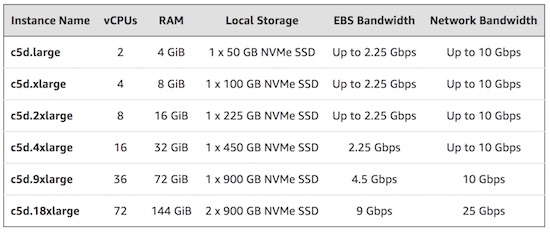 HPC in the Cloud got a boost this week with this announcement of two updates to the Amazon EC2 instance family: the general availability of EC2 Bare Metal instances and C5D instances with local SSD storage.
HPC in the Cloud got a boost this week with this announcement of two updates to the Amazon EC2 instance family: the general availability of EC2 Bare Metal instances and C5D instances with local SSD storage.
- EC2 Bare Metal instances provide customers’ applications with direct access to the processor and memory resources of the underlying server. These instances are ideal for workloads that require access to the hardware feature set (such as Intel VT-x), or for applications that need to run in non-virtualized environments for licensing or support requirements.
- C5D instances with local SSD storage are designed for applications that benefit from high-speed, ultra-low latency local storage, such as video encoding, manipulation, and other forms of media processing that often include large numbers of reads and writes to temporary storage. Other than the addition of local storage, C5 and C5d instances share the same specs – both are powered by 3.0 GHz Intel Xeon Platinum 8000-series processes.
Bare metal available today
Amazon Elastic Compute Cloud (EC2) bare metal instances provide your applications with direct access to the processor and memory resources of the underlying server.
These instances are ideal for workloads that require access to the hardware feature set (such as Intel VT-x), or for applications that need to run in non-virtualized environments for licensing or support requirements. Bare metal instances are built on the Nitro system, a collection of AWS-built hardware offload and server protection components that come together to securely provide high performance networking and storage resources to EC2 instances. Bare metal instances were announced for preview at AWS re:Invent 2017, and are now generally available with the EC2 Storage Optimized I3 instance family in the form of i3.metal instances.
Bare metal instances allow EC2 customers to run applications that benefit from deep performance analysis tools, specialized workloads that require direct access to bare metal infrastructure, legacy workloads not supported in virtual environments, and licensing-restricted Tier 1 business critical applications. Bare metal instances also make it possible for customers to run virtualization secured containers such as Clear Linux Containers. Workloads on bare metal instances continue to take advantage of all the comprehensive services and features of the AWS Cloud, such as Amazon Elastic Block Store (EBS), Elastic Load Balancer (ELB) and Amazon Virtual Private Cloud (VPC).

Bare metal I3 instances have been in production since August of 2017, powering the VMware Cloud on AWS service that launched after 18 months of joint development and testing effort between VMware and AWS. This unique hybrid cloud offering enables customers to use their existing VMware based deployment and management methodology to extend their on-premises data center environments into the AWS Cloud. Bare metal instances enable VMware to run their full suite of software, including vSphere Hypervisor, directly on EC2 managed infrastructure.
As a new instance size belonging to the I3 instance family, bare metal I3 instances have the same characteristics as other instances in the family, including NVMe SSD-backed instance storage optimized for low latency, very high random I/O performance, and high sequential read throughput. I3.metal instances are powered by 2.3 GHz Intel Xeon processors, offering 36 hyper-threaded cores (72 logical processors), 512 GiB of memory, and 15.2 TB of NVMe SSD-backed instance storage. These instances deliver high networking throughput and lower latency with up to 25 Gbps of aggregate network bandwidth using Elastic Network Adapter (ENA)-based Enhanced Networking.
EC2 Instance Update – C5 Instances with Local NVMe Storage (C5d)
Driven by increasingly powerful processors and designed to address an ever-widening set of use cases, the size and diversity of this list reflects the equally diverse group of EC2 customers!
With a 25% to 50% improvement in price-performance over the C4 instances, the C5 instances are designed for applications like batch and log processing, distributed and or real-time analytics, high-performance computing (HPC), ad serving, highly scalable multiplayer gaming, and video encoding. Some of these applications can benefit from access to high-speed, ultra-low latency local storage. For example, video encoding, image manipulation, and other forms of media processing often necessitates large amounts of I/O to temporary storage. While the input and output files are valuable assets and are typically stored as Amazon Simple Storage Service (S3) objects, the intermediate files are expendable. Similarly, batch and log processing runs in a race-to-idle model, flushing volatile data to disk as fast as possible in order to make full use of compute resources.



